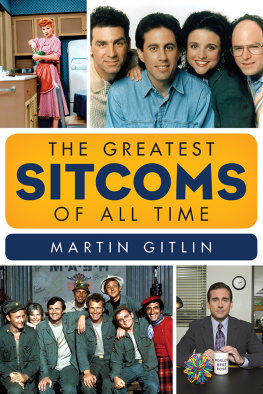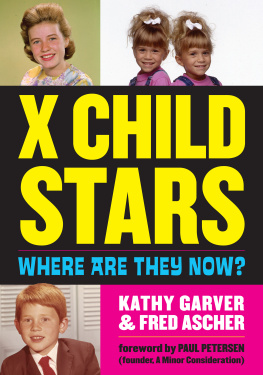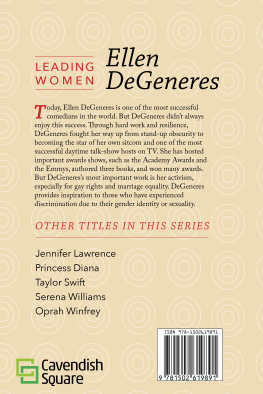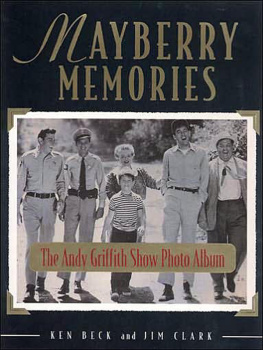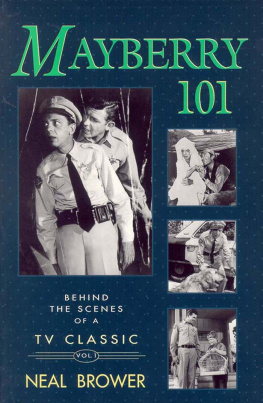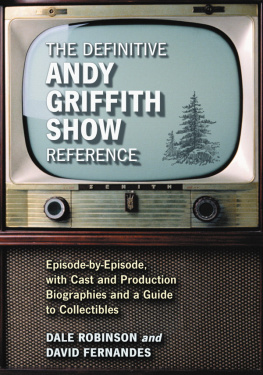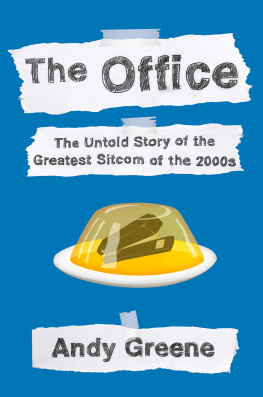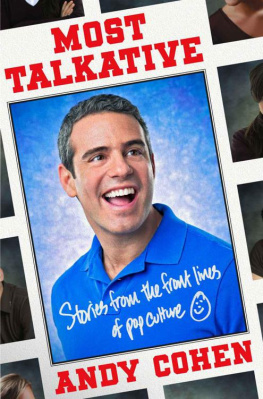

COPYRIGHT 1981 BY RICHARD KELLY
LIBRARY OF CONGRESS CATALOG CARD NUMBER: 8424597
ISBN 0-89587-043-6
ALL RIGHTS RESERVED
PRINTED IN THE UNITED STATES OF AMERICA
Eleventh Printing, 2002
Library of Congress Cataloging in Publication Data
Kelly, Richard Michael, 1937
The Andy Griffith show.
Includes index.
1. Andy Griffith show (Television program) I. Title. PN1992.77.A573K4 1984 791.45'72 84-24597 ISBN 0-89587-043-6
To Barbara
Contents
Preface
Twenty-five years have passed since Americans were first introduced to Mayberrys sheriff without a gun. At the time I was involved in graduate study at Duke University in Durham, North Carolina, and was amused at the local references made on the show to Raleigh, Mt. Pilot (Pilot Mountain), and Siler City. I quickly became a faithful viewer and eventually found myself a more knowledgeable citizen of Mayberry than I was of the city I lived in. As the seasons passed I grew familiar with all of Mayberrys townspeople and soon got to know their habits better than those of my actual associates. It wasnt long before I knew the Mayberry Union High theme song, Barneys middle name, and Andys favorite meal. When the show went off the air in 1968, I was able to see it all over again in reruns and can do so to this day. My involvement with the series has finally led me to write this book. It is my hope that in the process of explaining how the show was produced and developed I will provide not only an entertaining and informative account of how a television program is created and grows into a national and international success but also an answer to how a fictitious group of people can arrest and delight the imagination.
A casual viewer of The Andy Griffith Show might well wonder why anyone would choose to write a book about it, indeed, about any television program. Outside of The Making of Star Trek (1968), there have been few serious, extended studies of particular television shows. Lucy & Ricky & Fred & Ethel: The Story of I Love Lucy (1976) and M*A*S*H: the Inside Story of TVs Most Popular Show (1981) present thorough accounts of the programs but focus more upon the actors personalities than upon the craft and artistry of the series. A prevalent attitude among intellectuals is that television is throw-away entertainment, not art. Some publishers have a standing policy not to accept studies of television programs or motion pictures. One is reminded of the nineteenth-century attitude towards novelsthat they were throw-away entertainment. In Shakespeares day plays were considered ephemeral and most were not published. Obviously, there are thousands of plays, novels, and television programs unworthy of study. The medium of television, however, does not prevent a show from being a work of art, although because of pressures of time and money, a television program is more likely to be compromised than a novel or play. The Andy Griffith Show, for example, appeared for about thirty-two consecutive weeks each year for eight years. With a schedule like that, there inevitably will be poor shows and repetition of themes. In fact, it is a wonder that any artistry whatsoever could be achieved and maintained. And yet it was. Unlike so many programs today that begin with a slick pilot and then degenerate, the Griffith Show actually improved with time. Beneath its simple rustic setting lies a high degree of sophistication. The acting, writing, production, directing, and scoring were painstakingly worked out and blended to produce one of the more popular and artistic creations of the 1960s.
Ideally one should plan to write about a show that is in production. My task was complicated by the passage of time since the show went off the air. The Desilu Studio, where the series was filmed, is now a warehouse; the sets have all been auctioned or destroyed; shooting schedules and production details have been discarded; two of the actors, Paul Hartman (Emmett the fix-it man) and Howard McNear (Floyd the barber), are dead; and Frances Bavier (Aunt Bee) has retired to Siler City, North Carolina, and declines to be interviewed. But many riches remain. Andy Griffith has a bound set of all the scripts from the show, which he made available to me. Ron Jacobs provided me with a print of the pilot for the series, Danny Thomas Meets Andy Griffith. Jack Dodson preserved several working scripts, which he gave to me. And Don Knotts, Frances Bavier, and Viacom have sent me many photographs that were taken during the filming of the show. Finally, I made several trips to Los Angeles to make extensive tape-recorded interviews with the people chiefly responsible for the series: Andy Griffith, Don Knotts, Jack Dodson (Howard Sprague), Sheldon Leonard (Executive Producer), Aaron Ruben (Producer-Writer), Richard O. Linke (Associate Producer), Ron Jacobs (Associate Producer), and Earl Bellamy (Director).
In Part One I have allowed these people to unfold the story of The Andy Griffith Show in their own words. Their various convictions and perspectives, sometimes at odds with those of other members of the company, reveal the dynamic and complex nature of a production company dedicated to two sets of goals: financial success and high ratings on the one hand, and the creation of wholesome comedy with a high level of artistic integrity on the other. Amazingly, these seemingly contradictory goals were realized, and that is an extraordinary event in television history.
After tracing in Part One the development of the show from its conception to its conclusion, I have in Part Two examined the artistic qualities of the series that made it a television classic. This revised edition carries a new chapter in Part Two in which I have discussed the contributions made to the series by two of its best writers, Harvey Bullock and Everett Greenbaum.
Part Three contains completely new material that examines what has happened since this book was first published in 1981. The chapter entitled Dont Look Back provides updates on the careers of various cast members and features excerpts from recent interviews with members of the cast who were not available during the writing of the first edition. Mayberry in the 1980s discusses the phenomenal growth of interest in the show that is currently taking place. This chapter also includes information on two organizations that were founded to celebrate The Andy Griffith Show and to promote the airing of the show in local communities.
Parts Four and Five are comprised of supplemental material for the serious student of the show. A second script has been added to Part Four. The new script is entitled The Wandering Minstrel and, although it contains many of the classic elements of the series, it was never filmed. Part Five contains a listing and summary (with some revision of details) of all 249 episodes of the show, arranged according to the dates of their original presentation.
I want to thank the many people who helped me in writing this book: Andy Griffith, Richard Linke, Don Knotts, Jack Dodson, Aaron Ruben, Sheldon Leonard, Earl Bellamy, and Ron Jacobs for their generosity in granting me extended interviews and for responding to my subsequent letters requesting further information and materials. I am particularly indebted to Richard Linke for his strong and continued support of my project and for opening a number of doors otherwise closed to me. I want to thank Barbara Matchett, Don Knotts secretary-manager, for getting Don and me together despite some last-minute problems in our schedules. I owe a debt of gratitude to Thomas Wheeler and Richard Goode for their helpful critical observations about the show. My wife Barbara I thank for her careful reading of the manuscript and for her many good suggestions for its revision. Special thanks go to Becky Caldwell, Ernest Lee, and Les White for their invaluable assistance with the plot summaries. I would also like to acknowledge both the support and criticial suggestions given to me by George McDaniel and my publisher, John F. Blair. I also thank the trustees of the John C. Hodges Better English Fund at the University of Tennessee for a travel grant that allowed me to make two trips to Los Angeles, where I interviewed most of the principals of the show.
Next page

